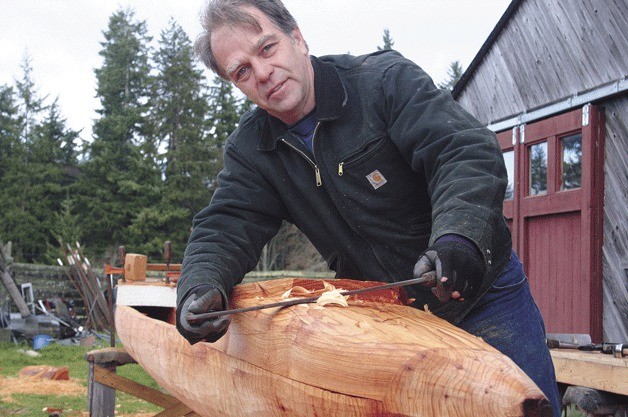Brad Rice has built and restored classic wooden boats for 30 years, but this time he went right to the source.
Rice’s barn on East Harbor Road north of Freeland is filled with watercraft in various stages of refurbishment. Out front, however, is a little boat in progress laying across sawhorses and surrounded by fragrant wood shavings.
Less than a month ago, it was a tree growing in a neighbor’s yard, probably with birds and squirrels squatting in it.
“It’s kind of fun to go out in the woods and find a tree and get a boat,” Rice said Thursday as he pulled loose another slice of Western red cedar with a traditional adz that a friend made for him.
“And it’s lots of fun to get that feeling of creating something traditional,” he added.
Rice, known around the South End as The Boatwright, is about halfway finished with a dugout canoe modeled after a handmade design used for hundreds of years in the South Pacific.
Rice said this particular model was created by the inhabitants of a small island south of the Marshalls in Micronesia, probably for use in lagoons and reefs, and for offshore fishing.
“They go all over the place in them,” he said.
Rice found the plans dating to the 1930s on the website of the Journal of the Polynesian Society. Designed for four or five paddlers, the slender craft will sport a wooden outrigger for stability, a distinctive bow and a carved “fish-lips” tail in the back.
Rice is crafting the canoe from a 25-foot tree that was about 2½ feet in diameter at its base, and about 20 inches around at the top. The canoe itself is 21 feet long.
Its pieces traditionally would be held together with fibers from the husks of coconuts, “but I’m not sure I can find the real McCoy,” he said.
Rice is carving the canoe for a prosperous Yakima fruit grower, who wants to hang it on the wall of his pool house as decoration, along with his other Polynesian collectables.
But the client, for whom Rice also built two teak kayaks in 1992, is giving him free rein with the project, which Rice expects to complete in a couple of weeks. He keeps the client up to date via photos on Facebook.
“He was pretty open,” Rice said. “It’s great to have a chance to do something interesting and fun and different.”
He said he may coat the canoe with a little oil to preserve it, but there will be no sanding, and all the carving marks will be retained.
“I want to keep it as interesting and honest as possible,” he said.
Rice, 53, built his first wooden boat when he was 20, a replica of a gaff-rigged yawl that caught his fancy. The experience convinced him to turn pro, and he traveled to England for specialized training in building wooden boats.
Rice has been in business on Whidbey since 2005, after 18 years in a leased shop in Ballard. He said he and his family moved to the island so they could live and work on the same piece of property.
His wife, Camille LaTray, is the owner of the popular take-out garden The Raven and The Spade, located between Rice’s barn and East Harbor Road.
Rice has worked with boats ranging from dinghies to a houseboat that was too big for his barn door and had to be removed in two pieces. Near the front is a wooden power boat he has been building in stages for the past two years.
Rice restored a 1926 classic sailboat designed by the legendary Ted Geary that wound up on a historic preservation list, and is on display at the Center for Wooden Boats at Lake Union in Seattle.
Amid the powerboats, rowboats, racing shells and classic sailing hulls inside Rice’s 3,600-square-foot barn sits the 23-foot 1950 yawl “Blue Moon,” the original inspiration for his first boat, which itself is propped up a few yards out in front.
“It’s a boat-building Mecca on Whidbey Island,” Rice said with a smile.
But for now, Rice is occupied with the craftsmanship going into the dugout canoe, the fashioning of a functional work of art with simple hand tools — many of which, such as the adz and a curved draw knife, are works of art themselves.
The canoe’s new owner plans to display it with his collection of Polynesian paddles, nets and mats, but Rice has plans for his pride and joy before he sends it over the mountains.
“I’m going to launch it first,” Rice said. “I told him that like all boats, it has to go in the water at least once.”
He said the launch may be in Holmes Harbor, but more likely in Lone Lake.
“He’s concerned about it going in salt water,” Rice said. “To me, water is water.”
For more information, visit www.theboatwright.com.



